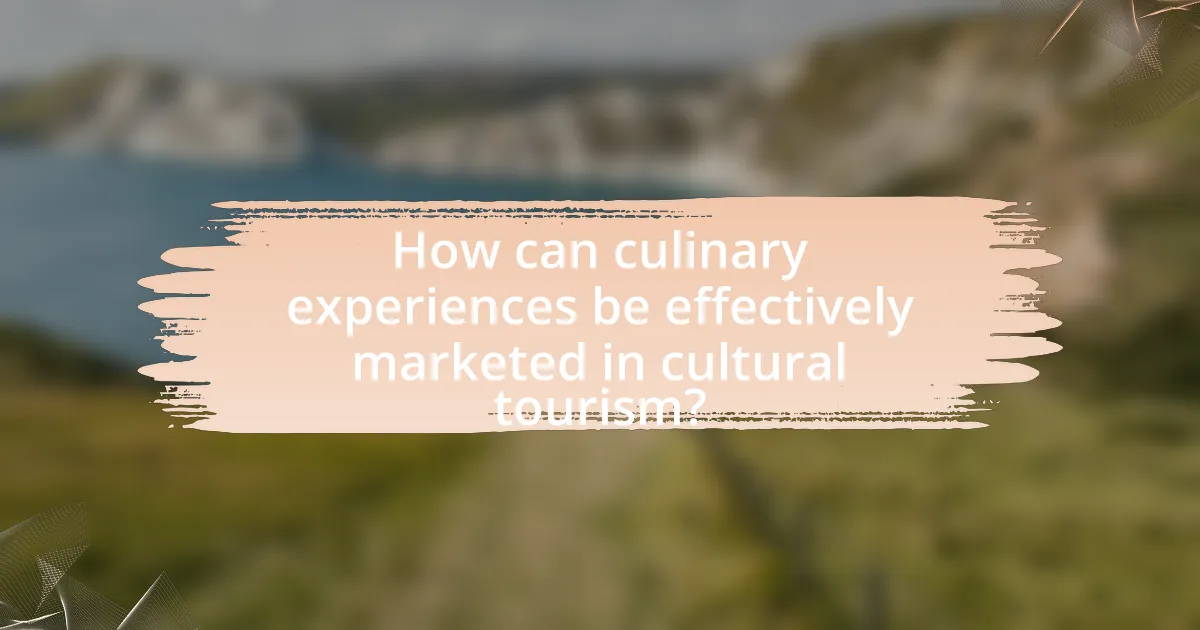Culinary experiences are integral to cultural tourism, providing travelers with opportunities to engage with local traditions, flavors, and customs. These experiences not only enhance cultural understanding but also stimulate local economies by promoting regional products and supporting local chefs and restaurants. The article explores how culinary tourism fosters cultural exchange, highlights popular food-related activities, and examines the economic impacts on local communities. Additionally, it addresses challenges such as authenticity and sustainability, while offering strategies for effectively marketing culinary experiences to enhance tourism.

What is the Role of Culinary Experiences in Cultural Tourism?
Culinary experiences play a crucial role in cultural tourism by serving as a gateway for travelers to engage with local traditions, flavors, and customs. These experiences allow tourists to immerse themselves in the culture of a destination through food, which often reflects the history and identity of a community. For instance, studies show that 88% of travelers consider food experiences as an essential part of their travel plans, highlighting the significance of gastronomy in enhancing cultural understanding and appreciation. Furthermore, culinary tourism can stimulate local economies by promoting regional products and supporting local chefs and restaurants, thereby fostering a sustainable tourism model that benefits both visitors and residents.
How do culinary experiences enhance cultural tourism?
Culinary experiences enhance cultural tourism by providing authentic insights into local traditions, flavors, and social practices. These experiences allow tourists to engage directly with the culture through food, which serves as a reflection of a region’s history and identity. For instance, studies show that food-related activities, such as cooking classes or food tours, can increase tourist satisfaction and encourage longer stays, as they foster deeper connections with the local community. According to a report by the World Food Travel Association, 93% of travelers consider food an essential part of their travel experience, highlighting its significance in cultural tourism.
What specific culinary experiences are most popular among tourists?
Culinary experiences most popular among tourists include food tours, cooking classes, and local market visits. Food tours allow tourists to sample regional dishes and learn about local culinary traditions, often highlighting street food and iconic restaurants. Cooking classes provide hands-on experiences where participants can learn to prepare traditional dishes, fostering a deeper connection to the culture. Local market visits enable tourists to explore fresh ingredients and interact with local vendors, enhancing their understanding of the culinary landscape. According to a study by the World Food Travel Association, 93% of travelers consider food an essential part of their travel experience, underscoring the significance of these culinary activities in cultural tourism.
How do local cuisines reflect cultural identity in tourism?
Local cuisines reflect cultural identity in tourism by showcasing traditional ingredients, cooking methods, and culinary practices unique to a region. These elements serve as a tangible representation of a community’s history, values, and social practices, allowing tourists to engage with the local culture. For example, the use of specific spices in Indian cuisine not only highlights regional agricultural practices but also reflects historical trade routes and cultural exchanges. Furthermore, culinary festivals and local food markets often celebrate these traditional dishes, reinforcing community identity and attracting tourists who seek authentic experiences. This connection between food and cultural identity enhances the overall tourism experience, making it more immersive and meaningful.
Why are culinary experiences important for cultural exchange?
Culinary experiences are important for cultural exchange because they serve as a tangible representation of a culture’s history, traditions, and values. Through food, individuals can engage with and understand diverse cultural practices, fostering mutual respect and appreciation. For instance, UNESCO recognizes traditional cuisines as part of cultural heritage, highlighting how shared meals can bridge cultural divides and promote dialogue. Additionally, research indicates that culinary tourism contributes significantly to local economies, with travelers seeking authentic food experiences that reflect the local culture, thus enhancing cultural understanding and exchange.
How do food-related activities promote understanding between cultures?
Food-related activities promote understanding between cultures by facilitating shared experiences and fostering communication through culinary traditions. Engaging in cooking classes, food festivals, or communal meals allows individuals from different backgrounds to interact, share stories, and learn about each other’s customs and values. For instance, research by the University of California found that culinary tourism enhances cross-cultural interactions, as participants often discuss the origins and significance of dishes, leading to greater cultural appreciation. Additionally, food serves as a universal language, breaking down barriers and creating connections among diverse groups, which is essential for cultural exchange and understanding.
What role do culinary festivals play in cultural tourism?
Culinary festivals play a significant role in cultural tourism by showcasing local food traditions and enhancing the visitor experience. These festivals attract tourists who seek authentic cultural experiences, allowing them to engage with local cuisine, chefs, and culinary practices. For instance, events like the Taste of Chicago or the Melbourne Food and Wine Festival not only promote regional dishes but also stimulate local economies by increasing foot traffic and generating revenue for restaurants and vendors. According to a study by the World Food Travel Association, 93% of travelers consider food an important part of their travel experience, highlighting the integral connection between culinary festivals and cultural tourism.

What are the economic impacts of culinary experiences in cultural tourism?
Culinary experiences in cultural tourism significantly boost local economies by increasing tourist spending and creating jobs. Tourists often allocate a substantial portion of their budget to food-related activities, which can account for up to 30% of their total travel expenditures, as reported by the World Food Travel Association. This spending supports local restaurants, markets, and food producers, thereby stimulating economic growth in the region. Additionally, culinary tourism generates employment opportunities in various sectors, including hospitality, agriculture, and food production, contributing to overall economic development.
How do culinary experiences contribute to local economies?
Culinary experiences significantly contribute to local economies by driving tourism, creating jobs, and supporting local agriculture. These experiences attract visitors who spend money on dining, tours, and related activities, which stimulates economic growth. For instance, a study by the National Restaurant Association found that the restaurant industry alone contributed over $899 billion to the U.S. economy in 2020, highlighting the substantial financial impact of culinary tourism. Additionally, local restaurants often source ingredients from nearby farms, fostering a symbiotic relationship that bolsters the agricultural sector. This interconnectedness enhances community resilience and promotes sustainable economic development.
What types of businesses benefit from culinary tourism?
Restaurants, food producers, and local markets benefit significantly from culinary tourism. These businesses attract tourists seeking authentic food experiences, which can lead to increased sales and brand recognition. For instance, a study by the World Food Travel Association found that culinary tourists spend approximately 25% more than other travelers, highlighting the economic impact on restaurants and food-related businesses. Additionally, wineries, breweries, and cooking schools also thrive as they offer unique experiences that cater to the interests of culinary tourists, further enhancing local economies.
How does culinary tourism affect employment in local communities?
Culinary tourism significantly boosts employment in local communities by creating job opportunities in various sectors such as hospitality, food production, and local markets. This form of tourism encourages the establishment of restaurants, food tours, and culinary classes, which directly leads to increased hiring of chefs, servers, tour guides, and support staff. For instance, a study by the World Food Travel Association found that culinary tourism can generate up to 30% of total tourism revenue in some regions, thereby enhancing local job markets and stimulating economic growth. Additionally, local farmers and producers benefit from increased demand for regional ingredients, further contributing to job creation in agriculture and food supply chains.
What challenges do culinary experiences face in cultural tourism?
Culinary experiences in cultural tourism face several challenges, including authenticity, sustainability, and accessibility. Authenticity is crucial as tourists seek genuine local flavors, but this can be compromised by commercialization and the influence of global food trends. Sustainability poses a challenge as the demand for local ingredients can strain resources and lead to environmental degradation. Accessibility is also a significant issue, as not all culinary experiences are easily reachable for tourists, particularly in remote areas. These challenges can hinder the effectiveness of culinary tourism in promoting cultural heritage and local economies.
How do cultural appropriation issues impact culinary tourism?
Cultural appropriation issues significantly impact culinary tourism by influencing perceptions of authenticity and ethical consumption. When culinary practices from one culture are adopted by another without proper acknowledgment or respect, it can lead to backlash from the originating culture, which may discourage tourists from engaging with those culinary experiences. For instance, the rise of “fusion” cuisine often faces criticism for diluting traditional dishes, leading to a demand for more authentic experiences. According to a study published in the Journal of Tourism and Cultural Change, 70% of respondents expressed a preference for dining experiences that honor the cultural origins of the food, highlighting the importance of authenticity in culinary tourism. This indicates that cultural appropriation not only affects the reputation of culinary offerings but also shapes consumer choices, ultimately impacting the economic viability of culinary tourism in regions rich in cultural heritage.
What are the sustainability concerns related to culinary tourism?
Sustainability concerns related to culinary tourism include environmental degradation, cultural commodification, and resource depletion. Environmental degradation arises from increased waste generation and carbon emissions associated with food production and transportation, as culinary tourism often relies on local ingredients that may not be sustainably sourced. Cultural commodification occurs when local culinary traditions are commercialized, potentially leading to the loss of authenticity and cultural heritage. Resource depletion is a significant issue, as the demand for local food can strain water and land resources, particularly in regions already facing environmental challenges. For instance, a study by the United Nations World Tourism Organization highlights that tourism can exacerbate food insecurity in vulnerable communities, emphasizing the need for sustainable practices in culinary tourism.

How can culinary experiences be effectively marketed in cultural tourism?
Culinary experiences can be effectively marketed in cultural tourism by leveraging storytelling, local partnerships, and digital platforms. Storytelling engages potential tourists by highlighting the cultural significance and unique narratives behind local dishes, which can enhance their emotional connection to the experience. Collaborating with local chefs, restaurants, and food artisans creates authentic offerings that reflect the region’s culinary heritage, making the experiences more appealing. Additionally, utilizing digital platforms such as social media and travel websites allows for targeted marketing, reaching a broader audience and showcasing visually enticing content that attracts food enthusiasts. According to a study by the World Food Travel Association, 93% of travelers consider food an essential part of their travel experience, underscoring the importance of effectively marketing culinary tourism.
What strategies are most effective for promoting culinary tourism?
Effective strategies for promoting culinary tourism include leveraging local food festivals, collaborating with chefs and restaurants, and utilizing social media marketing. Local food festivals attract visitors by showcasing regional cuisine and culture, as evidenced by events like the Taste of Chicago, which draws over 1.5 million attendees annually. Collaborating with chefs and restaurants enhances authenticity and provides unique dining experiences, as seen in initiatives like the “Farm-to-Table” movement, which emphasizes local sourcing. Social media marketing, particularly through platforms like Instagram, allows for visually appealing content that can reach a global audience, with studies indicating that 79% of people say user-generated content highly impacts their purchasing decisions. These strategies collectively enhance visibility and engagement in culinary tourism.
How can social media influence culinary tourism marketing?
Social media significantly influences culinary tourism marketing by enhancing visibility and engagement with potential travelers. Platforms like Instagram and Facebook allow culinary destinations to showcase local cuisine through visually appealing content, attracting food enthusiasts. According to a study by the World Tourism Organization, 40% of travelers are influenced by social media when choosing a destination, highlighting its role in shaping travel decisions. Additionally, user-generated content, such as reviews and photos, fosters authenticity and trust, further driving interest in culinary experiences. This dynamic interaction between social media and culinary tourism creates a powerful marketing tool that can effectively reach and engage target audiences.
What role do food bloggers and influencers play in culinary tourism?
Food bloggers and influencers significantly shape culinary tourism by promoting destinations through their food experiences and recommendations. They create engaging content that showcases local cuisines, restaurants, and food festivals, which attracts tourists seeking authentic culinary experiences. According to a study by the World Food Travel Association, 93% of travelers consider food an essential part of their travel experience, highlighting the influence of food-related content on travel decisions. Additionally, food bloggers and influencers often have large followings on social media platforms, allowing them to reach a wide audience and inspire travel to specific locations based on their culinary offerings. Their authentic storytelling and visual appeal can enhance a destination’s reputation, making them key players in the growth of culinary tourism.
What best practices should be followed for successful culinary tourism experiences?
Successful culinary tourism experiences should prioritize authenticity, local engagement, and sustainability. Authenticity ensures that tourists experience genuine local cuisine, which enhances their connection to the culture. Engaging local chefs and food producers fosters community involvement and provides tourists with insights into traditional cooking methods and ingredients. Sustainability practices, such as sourcing ingredients locally and minimizing food waste, not only support the environment but also resonate with the growing consumer demand for responsible tourism. According to a study by the World Food Travel Association, 93% of travelers consider food experiences an essential part of their travel, highlighting the importance of these best practices in creating memorable culinary tourism experiences.
How can local businesses collaborate to enhance culinary tourism?
Local businesses can collaborate to enhance culinary tourism by creating joint marketing initiatives and developing unique culinary experiences that showcase local ingredients and traditions. For instance, restaurants can partner with local farms to offer farm-to-table dining experiences, which not only attract tourists but also support the local economy. According to a study by the World Food Travel Association, culinary tourism can increase local revenue by up to 30% when businesses work together to promote regional food experiences. Additionally, local businesses can organize food festivals or culinary tours that highlight various dining options, thereby providing tourists with a comprehensive taste of the area’s culinary offerings.
What are the key elements of a memorable culinary experience for tourists?
A memorable culinary experience for tourists includes authentic local cuisine, engaging cultural context, and interactive dining experiences. Authentic local cuisine allows tourists to taste traditional dishes that reflect the region’s culture and history, enhancing their understanding of local customs. Engaging cultural context, such as storytelling about the origins of the dishes or the significance of ingredients, deepens the connection between the food and the culture. Interactive dining experiences, like cooking classes or food tours, provide hands-on involvement, making the experience more immersive and memorable. These elements collectively contribute to a rich culinary journey that resonates with tourists, fostering a lasting appreciation for the destination’s culinary heritage.